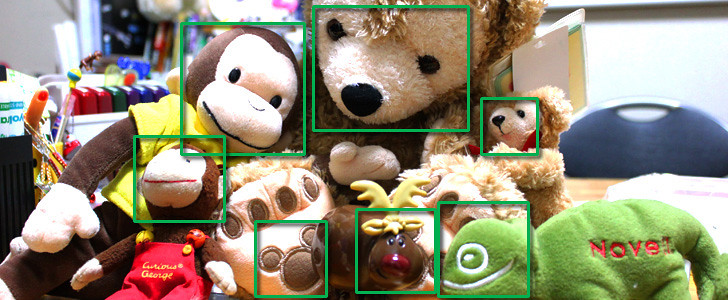Automatic Product Recognition from Picture
Have you ever wondered how your favorite online stores can recommend similar products just from a photo? This magical capability is thanks to automatic product recognition technology. As our lives become more digitally integrated, tools like these are transforming how we shop, work, and connect.
At its core, automatic product recognition uses artificial intelligence (AI) to identify and categorize items from pictures. Whether you’re snapping a photo of a trendy sneaker or cataloging inventory in bulk, this technology ensures speed and precision. In fact, based on Statista, the image recognition market is projected to grow to $53 billion by 2030, driven by increasing demand in e-commerce and other industries.
Imagine the possibilities: seamless shopping experiences, personalized ads, and even better medical tools. With AI-powered tools like picture recognition APIs and photo recognition APIs, these possibilities are now realities. Let’s dive deeper into how this works and why it’s becoming a game-changer across industries.
What is Automatic Product Recognition from Pictures?
Automatic product recognition is a cutting-edge technology that uses AI to identify objects from images. By analyzing features such as shape, color, and texture, AI algorithms can determine what the object is and categorize it accordingly.
The process begins when an image is uploaded. The AI scans it, breaks it into analyzable components, and compares these to vast datasets of labeled images. This enables the system to make accurate predictions about what’s in the picture.
Key to this technology are advancements in machine learning and computer vision. Machine learning enables systems to “learn” from data over time, improving their accuracy. Meanwhile, computer vision helps machines “see” and interpret visual information the way humans do. Combined, these technologies power the seamless experience we now expect from AI recognition tools.
How Does Automatic Product Recognition Work?
1. Image Processing and Analysis
The first step in product recognition is processing the uploaded image. AI tools analyze the photo, identifying key features such as contours, textures, and patterns. This visual data is then compared to a library of pre-existing images.
For instance, fashion retailers like ASOS use AI-powered picture recognition APIs to allow customers to upload images of clothing they like. The system identifies similar products in their inventory, enabling a more interactive shopping experience. This approach has significantly enhanced customer satisfaction by reducing the time spent searching for desired items.
2. Machine Learning Models
Machine learning models form the backbone of product recognition. Pre-trained models—trained on millions of labeled images—can identify products with high accuracy. For instance, models built using frameworks like TensorFlow or PyTorch excel in recognizing and categorizing a diverse range of items.
An example of this in action is Pinterest’s “Lens” feature, which uses machine learning to analyze photos and recommend similar pins or products. By integrating this feature, Pinterest has created a more intuitive platform that understands users’ visual preferences, driving higher engagement and increasing the time users spend on the app.
3. Integration with Image Identification APIs
Businesses often use image identification APIs to scale their product recognition capabilities. These APIs provide a bridge between raw image data and actionable insights.
For example, eBay’s image search functionality enables users to snap a photo of an item they want to buy. The platform’s image identification API matches the photo with available listings, streamlining the shopping process. This feature has significantly improved buyer satisfaction by reducing search times and providing more accurate results, contributing to increased transaction volumes on the platform.
Top Use Cases of AI Recognition Tools
1. Retail and E-commerce
In retail, product recognition is revolutionizing inventory management and customer experience. For example:
- Retailers can use AI to automatically catalog items, saving hours of manual effort.
- Shoppers can search for products by simply uploading a photo, creating a seamless and personalized shopping experience.
Case Study: Zalando
Zalando, a leading European e-commerce platform, implemented an AI-powered visual search tool called “Find Similar.” Users can upload photos of clothing or accessories they like, and the tool suggests similar items from its extensive catalog. This feature has been a game-changer for Zalando, leading to a 20% increase in user engagement. By eliminating the need for textual searches, Zalando has made it easier for users to find what they’re looking for, resulting in higher conversion rates and improved customer satisfaction.
2. Digital Marketing and Advertising
Marketers leverage product recognition to create highly targeted campaigns. Imagine uploading a picture of your living room and receiving furniture recommendations tailored to your style. AI tools also help brands analyze consumer preferences by studying uploaded images, enabling data-driven decisions.
Case Study: Coca-Cola
Coca-Cola uses AI recognition tools to analyze user-generated content on social media platforms like Instagram. By identifying Coca-Cola products in photos, the company gains valuable insights into how, where, and when its products are consumed. This data is then used to fine-tune marketing strategies, ensuring campaigns resonate with their target audience. For example, identifying trends in outdoor consumption led Coca-Cola to launch a summer campaign that boosted sales by 15%.
3. Healthcare and Medical Imaging
In healthcare, AI recognition tools identify medical supplies or equipment from photos, streamlining operations. Hospitals can manage inventory more efficiently, ensuring critical items are always in stock. Moreover, the technology has potential applications in diagnosing conditions through image analysis.
Case Study: IBM Watson Health
IBM Watson Health employs AI-powered image recognition to analyze medical images such as radiology scans. By identifying abnormalities like tumors or fractures, the system assists doctors in making faster and more accurate diagnoses. For example, a clinical trial involving Watson Health’s AI reduced diagnostic errors by 20%, highlighting the potential of this technology to improve patient outcomes.

Best Picture Recognition APIs for Automatic Product Recognition
The market offers several robust picture recognition APIs to simplify product recognition. Some leading options include:
- Google Cloud Vision API: Known for its high accuracy and ease of integration. For example, it’s used by retailers to analyze product images and automate tagging, reducing manual workloads significantly.
- Amazon Rekognition: Popular for its scalability and robust feature set. It’s frequently used in security applications, such as identifying objects in surveillance footage.
- Clarifai: A versatile API with strong customization options. Companies like OpenTable use Clarifai to analyze food images, helping users discover dishes or restaurants based on visual cues. This has enhanced user engagement and contributed to higher booking rates on the platform.
When selecting an API, consider factors like speed, accuracy, and ease of integration. Developers looking to explore this technology should experiment with photo recognition APIs and image identification APIs to find the best fit for their needs.
With its broad applications and rapid advancements, automatic product recognition from pictures is reshaping industries. From improving shopping experiences to streamlining operations, the possibilities are endless. Don’t miss out on leveraging this transformative technology to stay ahead of the curve!
Challenges and Limitations of Product Recognition from Images
While automatic product recognition is a revolutionary technology, it’s not without its challenges. These obstacles often highlight the need for ongoing improvement and innovation in the field.
1. Image Quality and Data Variability
AI systems rely heavily on the quality of images they process. Blurry, low-resolution, or poorly lit photos can hinder accurate recognition. For instance, a smartphone picture taken in dim light might fail to capture key product details, leading to incorrect categorization. Variability in data, such as different angles or partial views of a product, further complicates the recognition process.
Imagine a customer trying to upload an image of a vintage handbag. If the photo lacks clarity or the bag’s features aren’t visible, the AI might struggle to match it with similar products. This can lead to frustration and a poor user experience.
2. Ethical Concerns: Privacy and Data Security
The use of personal photos for product recognition raises valid ethical concerns. Users may worry about how their images are stored, shared, or used by companies. For example, if a shopper uploads a photo of their living room to find matching furniture, they’d expect that image to remain private.
Ensuring robust data encryption and compliance with privacy regulations like GDPR is crucial for maintaining user trust. Businesses must prioritize transparency, assuring customers that their data is secure and only used for intended purposes.
Future of Automatic Product Recognition Technology
The future of automatic product recognition is brimming with potential. Here are some exciting trends and predictions shaping this space:
1. Emerging Trends in AI-Powered Recognition Tools
As AI becomes more advanced, recognition tools are expected to handle increasingly complex tasks. For example, next-generation systems may identify not only what a product is but also its condition, age, or authenticity. This could revolutionize industries like secondhand marketplaces and luxury goods.
2. Advancements in API Capabilities
Picture recognition APIs and photo recognition APIs are becoming more sophisticated. Future APIs are likely to offer faster processing speeds, enhanced accuracy, and seamless integration with other platforms. For instance, developers might soon leverage APIs that support real-time product recognition in augmented reality (AR) environments. Imagine trying on clothes virtually by simply scanning your wardrobe at home!
3. Transformative Industry Applications
This technology has the power to reshape entire industries. In agriculture, for instance, AI could recognize plant diseases from photos, helping farmers take timely action. In logistics, product recognition tools could streamline warehouse operations by identifying and sorting items more efficiently.
Conclusion
Automatic product recognition from pictures is more than just a technological marvel; it’s a tool that’s simplifying lives and enhancing industries. From helping customers find the perfect product with a photo to improving operational efficiency in businesses, its applications are vast and transformative.
By leveraging AI recognition tools, image identification APIs, and photo recognition APIs, companies can stay ahead in a competitive landscape. While challenges like data security and image quality remain, the rapid advancements in this field promise an exciting future. Now is the time for businesses and developers to embrace this technology and unlock its full potential.
FAQ
1. What is automatic product recognition from pictures?
Automatic product recognition uses AI algorithms to identify and categorize products from images. It’s commonly used in retail, marketing, and healthcare to streamline processes and enhance user experiences.
2. How accurate are current AI recognition tools?
The accuracy of AI recognition tools depends on factors like image quality and the training data used. Leading APIs, such as Google Cloud Vision and Amazon Rekognition, boast high accuracy rates but may still face challenges with complex or low-quality images.
3. Are my photos safe when using product recognition tools?
Most reputable companies ensure that user photos are encrypted and comply with privacy laws. Always check the platform’s privacy policy to understand how your data is used and stored.
4. What industries benefit the most from this technology?
Industries like retail, e-commerce, healthcare, and logistics benefit significantly. For example, retailers use it for inventory management, while healthcare providers leverage it for medical imaging.
5. How can developers start using image identification APIs?
Developers can explore APIs like Google Cloud Vision, Amazon Rekognition, or Clarifai. These tools offer documentation and tutorials to help integrate product recognition capabilities into applications.
With this technology’s potential to revolutionize industries, the journey of exploration and innovation has only just begun!
Rashed is Generative AI SEO & Digital PR Consultant at Sinense. He has several years of experience and skills in SEO, GEO (Generative Engine Optimization) & Digital PR Specializing for B2B SaaS Brands.
You can connect with him through his Linkedin profile.














